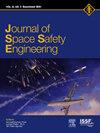An economic indicator of the orbital debris environment
IF 1
Q3 ENGINEERING, AEROSPACE
引用次数: 0
Abstract
The continued growth of orbital debris increases potential losses faced by commercial operators in Earth's orbits. Yet, there is no commonly accepted measure that describes the orbital debris environment from an economic perspective. This study begins to fill that gap by developing an Orbital Debris Economic Loss Index (ODELI) that measures and tracks the changes in the expected negative economic impact of orbital debris on satellite operators, both in aggregate and in specific orbits. Such information is valuable to the stakeholders, such as policymakers, commercial operators, and the public, in communicating valuable information about the economic state of the orbital debris environment.
We illustrate the calculation of the index utilizing the data from 2012 to 2022. The analysis is based on the publicly available data and the Meteoroid and Space Debris Terrestrial Environment Reference (MASTER) orbital debris environment model. Our analysis suggests that the aggregate expected economic damage to Earth's orbits is increasing at a slower rate than the growth rate of the number of satellites or trackable pieces of debris objects. The slower rate of growth in ODELI indices from 2012 to 2022 is explained by a decrease in the average mass of satellites, a reduction in the real cost of placing satellites in orbit, and a commercial preference to launch satellites into orbits with lower debris density.
The estimates of annual expected economic losses from debris collisions increased from $86 million to $107 million from 2012 to 2022, and the losses are concentrated in the low-Earth orbit (LEO). However, LEO had the smallest rate of increase in ODELI compared to other orbits. Medium-Earth orbit (MEO), which has the smallest contribution to the combined expected economic losses from debris on the Earth's orbits, experienced the fastest rate of increase in ODELI during the same period.
轨道碎片环境的经济指标
轨道碎片的持续增长增加了地球轨道上商业运营商面临的潜在损失。然而,目前还没有公认的从经济角度描述轨道碎片环境的衡量标准。本研究通过开发轨道碎片经济损失指数(ODELI)开始填补这一空白,该指数可测量和跟踪轨道碎片对卫星运营商的预期负面经济影响的变化,包括总体影响和特定轨道影响。这些信息对于政策制定者、商业运营商和公众等利益相关者来说非常有价值,可以传递有关轨道碎片环境经济状况的宝贵信息。我们利用 2012 年至 2022 年的数据对指数的计算进行了说明。分析基于公开数据和流星体和空间碎片地面环境参考(MASTER)轨道碎片环境模型。我们的分析表明,对地球轨道的总体预期经济损失的增长速度低于卫星或可跟踪碎片物体数量的增长速度。2012 年至 2022 年,ODELI 指数的增长速度较慢,原因是卫星的平均质量下降,将卫星送入轨道的实际成本降低,以及商业上倾向于将卫星发射到碎片密度较低的轨道。不过,与其他轨道相比,低地轨道的 ODELI 增长率最小。中地轨道(MEO)在地球轨道碎片造成的综合预期经济损失中占比最小,但同期的ODELI增长速度最快。
本文章由计算机程序翻译,如有差异,请以英文原文为准。
求助全文
约1分钟内获得全文
求助全文
来源期刊

Journal of Space Safety Engineering
Engineering-Safety, Risk, Reliability and Quality
CiteScore
2.50
自引率
0.00%
发文量
80
 求助内容:
求助内容: 应助结果提醒方式:
应助结果提醒方式:


